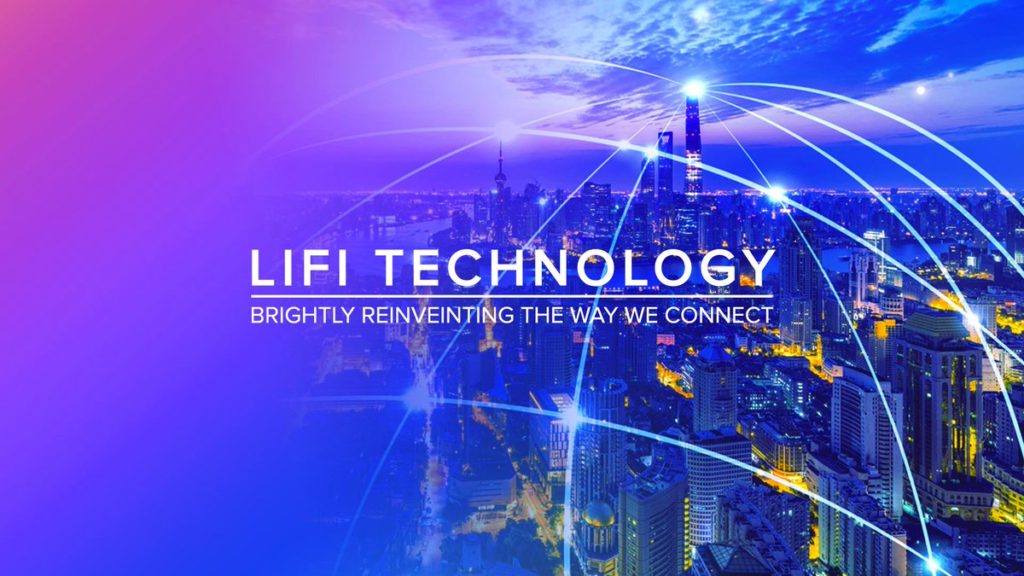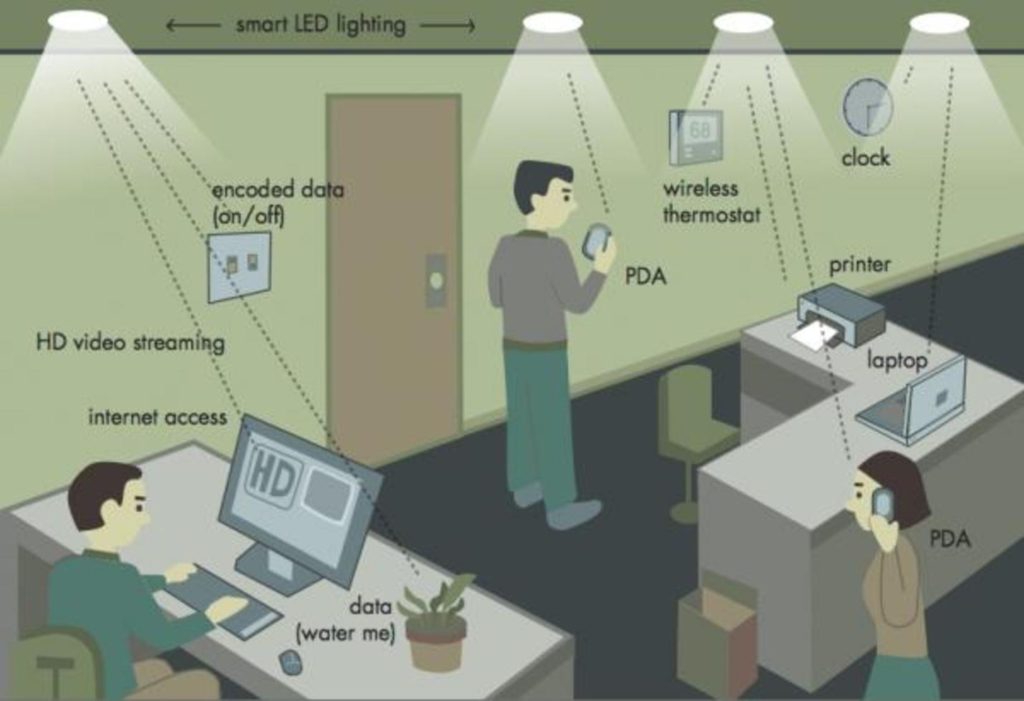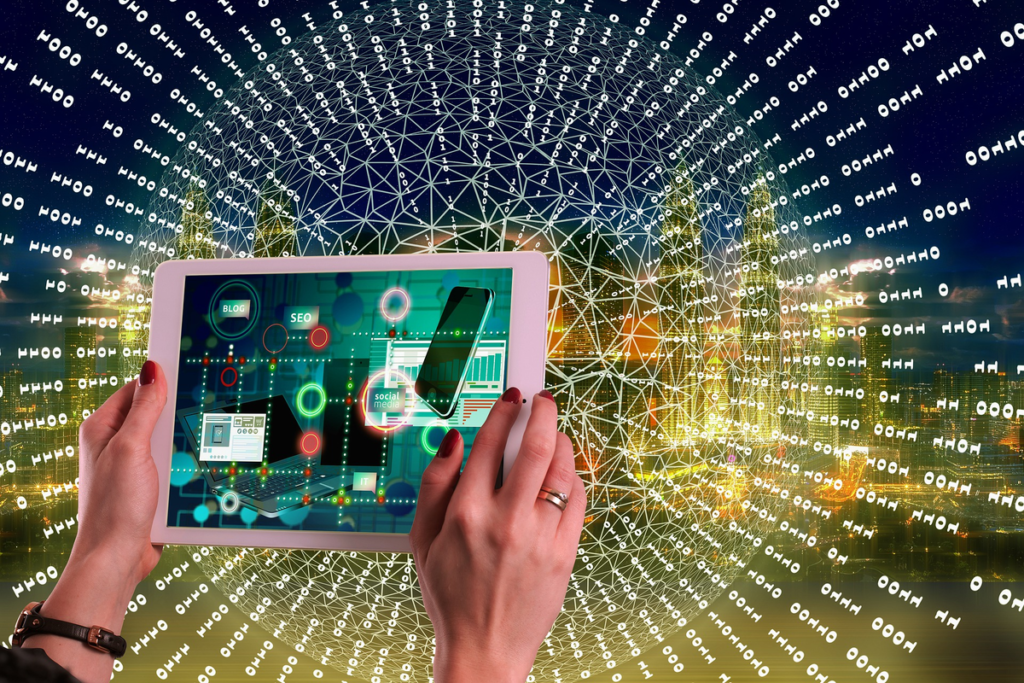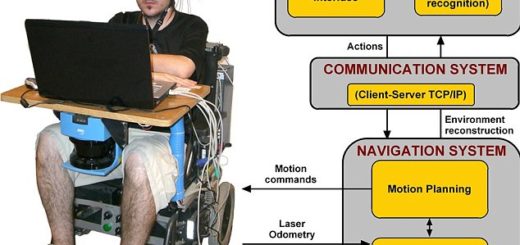SMART LEARNING USING LIFI TECHNOLOGY

ABSTRACT
Li-Fi stands for Light Fidelity. The technology is very new and it refers to visible light communication
(VLC) technology that uses light as a medium to deliver high-speed communication in a manner
similar to Wi-Fi. This technology can be used to help visually impaired people. Li-Fi can transmit
audio as well as other data. The purpose of the project is to help visually impaired people using lifi.
Blind people won’t be able to recognize what is going outside their house and what is happening
around them. This project will help them to know what is happening around them. The visuals from
CCTV surveillance are collected and monitored. And with the help of machine learning the activities
are recognized and are converted to audio data. This data is sent to the receiver on the body of the
blind person via lifi. Hence, they will be able to know what is happening around them. This project
will also help them to read a book using machine learning. TensorFlow and Kera’s platform help to
do machine learning algorithms simply. This project also uses the pay audio library to convert text to
audio. LiFi is a mobile wireless technology that uses light rather than radio frequencies to transmit
data. The technology is supported by a global ecosystem of companies driving the adoption of LiFi,
the next generation of wireless that is ready for seamless integration into the 5G core. Here the
hardware is used to create li-fi technology is 2 class D amplifier modules. The first amplifier module
receives the audio signal. in this stage, the signal strength is poor after amplifying the signal it’s given
to a LED light. When an electrical current is applied to a LED light bulb a stream of light (photons)
is emitted from the bulb. LED bulbs are semiconductor devices, which mean that the brightness of
the light flowing through them can be changed at extremely high speeds. This allows us to send a
signal by modulating the light at different rates. The signal can then be received by a detector which
interprets the changes in light intensity (the signal) as data. The intensity modulation cannot be seen
by the human eye, and thus communication is just as seamless as other radio systems, allowing the
users to be connected where there is LiFi enabled light. Using this technique, data can be transmitted
from a LED light bulb at high speeds.
INTRODUCTION
The term visual impairment refers to someone who is blind or partially sighted. It does not refer to
someone who is short-sighted (myopia) or long-sighted (hyperopia). Worldwide, about 314 million
people are visually impaired. Of these, approximately 14% (45million) are blind. Visible light
Communication (VLC) system employs visible light for wireless communication that occupy the
spectrum ranging from 380 nano meter to 750 nanometers. The paper describes an application of the
Visible Light Communication (VLC) in schools and homes. VLC technology issued for giving
information about different monuments in the museum. This approach to convey information aims to
replace current methods of delivering information using a MP3 player and other wireless technologies
such as Bluetooth or RF. The optical source, LED’s perform two functions, illumination and
transmission, simultaneously and is connected over the monuments. An audio information signal
issued as a modulation signal to vary the intensity of light emitted by the optical sources. This audio
signal contains the factual information related to the monuments. The receiver modules are connected
to headphones. The modulated optical signal is sense data photosensitive target a demodulated at the
receiver end. In this way, the factual information related to the monument is conveyed to the visitors.
The purpose of the project is to help visually impaired people using lifi. Blind people won’t be able to
recognize what is going outside their house and what is happening around them. This project will help
them to know what is happening around them. Surveillance is an integral part of security and is used
all over the world to ensure the safety of valuables as well as people. Even though surveillance is
controversial in some situations. Especially when connected to surveillance of human beings it is
necessary for other tasks like watching over valuables, monitoring operations, ensuring employee
safety as well as loss prevention and public safety. Surveillance, mostly, is a repetitive mostly trivial
task which raises the question: Can machines possibly automate surveillance? that deep learning has
surpassed human performance on most computer vision tasks. The same progress was also achieved
in the domain of object detection so yes, a deep learning model is more than capable to detect the right
objects in images most of the time. Object detection deals with detecting instances of a certain class,
like humans, cars, or animals in an image or video. It can achieve this by learning the special features
each object possesses. The TensorFlow Object Detection API is an open-source framework that allows
you to use pre trained object detection models or create and train new models by making use of transfer
learning.
This is extremely useful because building an object detection model from scratch can be difficult and
can take a very long time to train. Image classification involves predicting the class of object in an
image.
There are already pre-trained models in their framework which they refer to as Model Zoo.
This includes a collection of pre-trained models trained on the COCO dataset, the KITTI dataset, and
the Open Images Dataset. These models can be used for inference if we are interested in categories
only in this dataset. Object localization refers to identifying the location of one or more objects in an
image and drawing an abounding box around their extent.
Object detection combines these two tasks and localizes and classifies one or more objects in an
image.
● Classification—train the CNN to recognize categories like cats, dogs, cars, or anything else. The
system classifies the image as a whole, based on these categories. See our in-depth guide on Tensor
Flow Image Classification.
● Object Detection—more powerful than classification, it can detect multiple objects in the same
image. It also tags the objects and shows their location within the image. In this article, we focus
on the object detection approach in Tensor flow.
Steps for object detection. First, a deep learning model or algorithm is used to generate a large set
of bounding boxes spanning the full image (that is, an object localization component).
The figure 1.1 shows the object detection and in the figure we can see that it can classify one or
more objects in the image.

LITERATURE SURVEY
2.1 PRINCIPLE OF LIFI TECHNOLOGY
LIFI technology works on a very simple principle as a digital system does. With a high-speed variation
in the amplitude of light, transmission of data takes place through illumination. The data is converted
into binary forms of ‘1’ indicating the LED is on and ‘0’ to posit that the LED is off . The LED is
installed with a microchip to manage the variation in illumination which is at a speed invisible to
human eye. A photo detector at the receiver detects the photo using a photo sensitive device installed.
This send the further information to the display tool attached decoding the data back into its original
form.
2.2 AUDIO TRANSMISSION THROUGH LI-FI TECHNOLOGY
Due to the radio wave problem with the medical instruments the “Wi-Fi” technology become a
problem facing this challenge due to the interference of radio waves which may be harmful for the
patient. Multiple accesses “Wi-Fi” is having many challenges starting from the capacity, availability,
efficiency and security. Moreover, Wi-Fi transmit radio waves that may effect on medical instruments.
In this paper a proposed transmitter and receiver based on “Li-Fi” technology communication by using
“LEDs” which is line of sight only was done. A simple design to the “Li-Fi” is represented [4].
2.3 TRANSMISSION OF NUMERIC DATA AND VOICE USING LIGHT
FIDELITY (LIFI) TECHNOLOGY
LIFI is a field of research which has to cover several miles in each and every phase to prove its efficacy
as a potent technology that holds the strength to challenge the wide-ranging technology today. Be it
the radio spectrum which has continued to aggrandize and proliferate with times bringing in a high
competition. But LIFI stands among the technology by proving itself innocuous, non-hazardous, and
easy to use. A simple experiment to show the transmission of sound and numeric data (0-9, *, #) using
visible light communication is performed. The DTMF toner and a microphone are used as an input
selectively through a multi way switch and a speaker and an LCD display are used as outputting device.
The medium which binds the transmitter end to the receiver end is an LED source or the visible light
communication.
2.4 LI-FI BASED HIGH DATA RATE VISIBLE LIGHT COMMUNICATION
FOR DATA AND AUDIO TRANSMISSION
Light Fidelity (Li-Fi) is a data transfer technique that uses light. Light is analogous not only to
illumination but also to speed. Li-Fi is also much secured since light cannot pass through walls. It uses
visible light portion of the electromagnetic spectrum to transmit information. Hence the visible light
communication solves the problem of radio frequency congestion. In this project we transmit data and
audio through light at very high data rates without use of microcontrollers and its other peripheral
devices.
2.5 AUDIO TRANSMISSION THROUGH VISIBLE LIGHT COMMUNICATION
In today’s world where data security is one of the major concerns, it becomes vital to get new methods
for the data transmission. Visible Light Communication (VLC) is emerging as new method for data
transmission in which data is transmitted through LEDs. This is a much more secure method of
transmission compared to existing technologies. Also, the data transmission rate is very high around
few GBps. The use of various colored LEDs can produce different speeds and data rates. This paper
describes the design of Li-Fi audio transmission system and analyzing its performance [3].
PROPOSED METHODOLOGY
The purpose of the project is to help visually impaired people using lifi. It will help them to know what
is going outside their house and what is happening around them. The visuals from CCTV surveillance
are collected and monitored. And with the help of machine learning the activities are recognized and
are converted to audio data. This data is sent to the receiver on the body of the blind person via lifi.
Hence, they will be able to know what is happening around them.
This project will also help them to read a book using machine learning. Tensor flow and Keras platform
help to do machine learning algorithms. This project also uses the pay audio library to convert text to
audio. LiFi is a mobile wireless technology that uses light rather than radio frequencies to transmit
data. The figure 4.1 shows the block diagram of hardware section of the project. Here the hardware
issued to create lifi technology is 2 class D amplifier modules. The first amplifier module receives the
audio signal .in this stage, the signal strength is poor after amplifying the signal it’s given to a LED
light. When an electrical current is applied to a LED light bulb a stream of light (photons) is emitted
from the bulb. LED bulbs are semiconductor devices, which mean that the brightness of the light
flowing through the m can be changed at extremely high speeds. This allows us to send a signal by
modulating the light at different rates. The signal can then be received by a detector which interprets
changes in light intensity (the signal) as data. The intensity modulation cannot be seen by the human
eye, and thus communication is just as seamless as other radio systems, allowing the users to be
connected where the reis LiFi enabled light.

CONCLUSION AND FUTURE SCOPE
LI-FI is an emerging technology and hence it has vast potential. A lot of research can be conducted in
this field. And we can build a smart learning technology using lifi technology using lifi technology
using lifi technology using lifi technology using lifi technology with simple operation and high
economic benefits. The proposed model is an efficient and reliable system. The requirements and
implementation methodologies of the system is clearly explained. The system is simple hardware
interface design, highly reliable. The technology is very new and it refers to Visible Light
Communication (VLC) technology that uses light as a medium to deliver high speed communication
in a manner similar to Wi-Fi. This technology can be used to help visually impaired people. Li-Fi can
transmit audio as well as other data. LiFi is a mobile wireless technology that uses light rather than
radio frequencies to transmit data. The technology is supported by a global ecosystem of companies
driving the adoption of LiFi, the next generation of wireless that is ready for some integration into 5G
core
SOURCE CODE AND DETAILS FOR THIS PROJECT CONTACT 7510834013(whatsaap&call)
more all branch projects and project report , contact with US


































